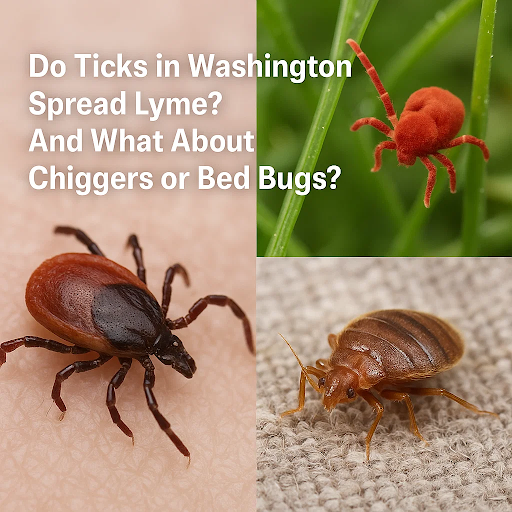
Introduction
Lyme disease is known in the northeastern and upper midwestern U.S. yet a lot of individuals are unaware of its presence or absence. Do ticks in Washington really spread Lyme disease? Can chiggers or bed bugs make you sick, too?
In this article, one will explore whether ticks in Washington actually are a risk factor, the facts about chiggers and bed bugs, identification of various bites and protecting yourself, and the prevention tips.
Let us clear the air and focus on the facts so one can stay safe and itch- free wherever you are.
Do Ticks in Washington Spread Lyme?
Washington hosts varied tick species, but specifically includes–
- Ixodes pacificus (primary Lyme vector)
- Ixodes angustus (are quite capable of nourishing Borrelia burgdorferi- the Lyme bacterium)
- Dermacentor andersoni (common in Eastern Washington, do not transmit Lyme).
Are ticks in Washington spreading Lyme?
Yes they can transmit and spread Lyme disease. However, the risk is low and mostly localised in nature. According to reports, Washington reported 34-40 % locally acquired tick- borne disease. And yet the records are little or none.
Have you wondered why the Lyme risk is low despite the tick presence?
- Geographical clustering: Localized hotspots such as Clallam County have slightly higher infection rates.
- Dilution effect: The Washington lizards are poor hosts for Lyme bacteria. This reduces infection rates in ticks.
- Low tick abundance: The tick habitat is confined to forest areas, brushy areas, and moist areas/ zones. For instance, Western ticks showcase relatively lower infection rates than Eastern ticks
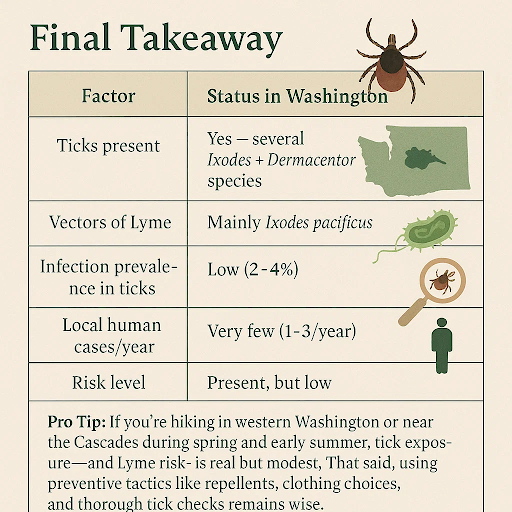
Chiggers: What they are and relation with Lyme
Chiggers grow in warm and humid environments. They are usually active in late spring, summer, and early fall. Chiggers can be bothersome at times but not dangerous. The bites cause discomfort but the chances of infection are quite rare.
The question is– can Lyme disease be caused by chiggers?
Chiggers cannot spread Lyme disease. Lyme illness is caused by the bacterium Borrelia burgdorferi, which is transmitted by the infected black- legged ticks. And chiggers do not carry or transmit Lyme in Washington or any other regions.
Chigger bites VS Tick bites
- Chigger bites are clusters of red, itchy bumps in appearance. They are not painful yet intense itching occurs within hours of the bite. There is no disease transmission.
- Tick bites are a single red spot or an elevated bump on the skin surface. It is painless initially but might be itchy later. There is a high possibility of transmission of Lyme or other tick related conditions.
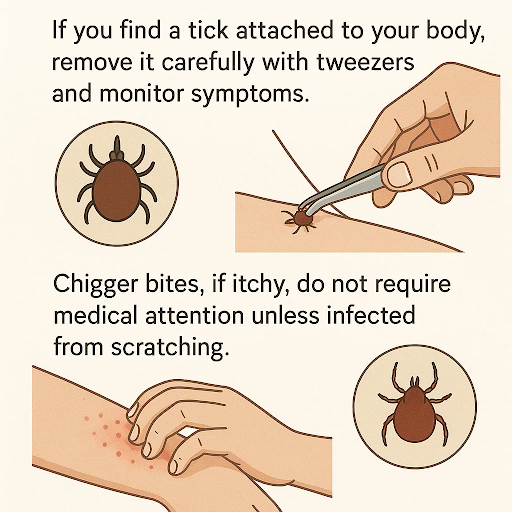
Bed Bugs: Annoying but not Dangerous?
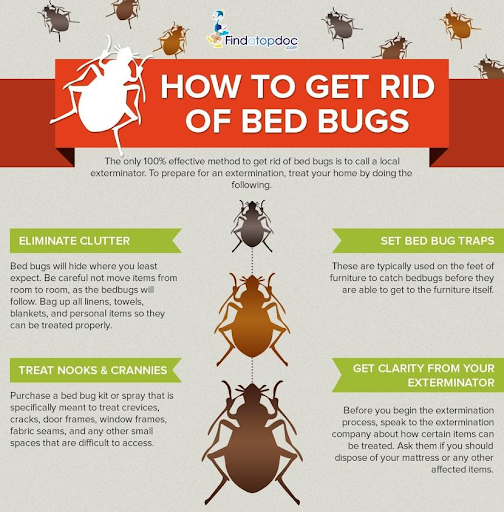
- Bed bugs (Cimex lectularius) are wingless insects that are fed on blood, chiefly from humans. The frequency of feeding is usually every 5- 7 days.
- And the activity time is during the night. They usually hide under the mattress, household items, luggage seams, and so on.
- Bed bugs are stimulated by carbon dioxide and heat. This is for the exact same reason they bite while one is asleep. The bites are not felt until later.
- Bites are in straight lines or clusters or groups– this pattern is also known as the “breakfast, lunch, and dinner” pattern.
Now the question arises, can bed bugs cause or spread Lyme disease/ any other illness?
- No, bed bugs do not transmit Lyme disease. In fact according to the research published, bed bugs are not vectors of disease like ticks or mosquitos.
- Even though bed bugs are not life- threatening, they can have serious impacts–
- Severe itching
- Secondary skin infection
- Mental health problems
- Cost eradication
Comparing Bites: Tick vs Chigger vs Bed bug
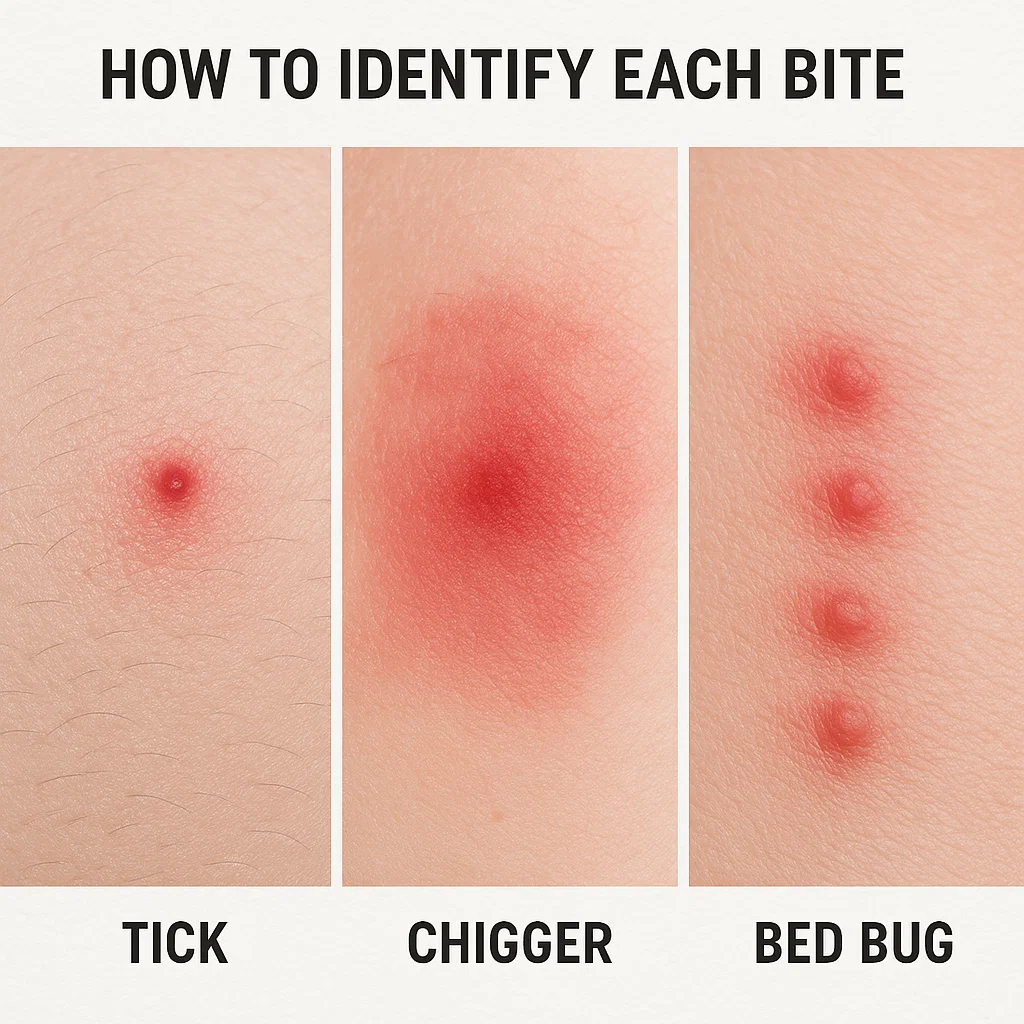
| Feature | Tick | Chigger | Bed Bug |
|
Biting stage |
Nymph/adult tick |
Larval mite |
Adult insect |
| Pain at bite |
Usually painless |
Often unnoticed at first |
Not felt during bite |
|
When itches start |
Several hours to a day later |
Within 1–6 hours |
Hours to overnight |
|
Bite location |
Anywhere |
Warm, tight areas |
Exposed skin during sleep |
| Pattern | Single site | Clustered red welts | Rows or zigzag clusters |
|
Risk of disease |
High |
None in North America |
None confirmed |
|
What to Do if Bitten |
- Remove tick ASAP with fine-tipped tweezers - Clean area with soap and water - Save the tick in a plastic bag. - Watch for rash or flu-like symptoms for 30 days |
- Wash area with soap and water - Apply anti-itch creams (calamine, hydrocortisone) - Take antihistamines if needed - Avoid scratching to prevent infection |
- Clean bite areas with soap and water - Apply anti-itch lotion or cold compress - Monitor for signs of infection - Inspect home and clean bedding, furniture, and luggage. |
How to avoid ticks in Washington?

Western Washington has relatively low Lyme risk. Ixodes ticks that carry Lyme disease eastern Washington (especially around forested and grassy areas).
Tick Tips:
- Wear light- colored clothing to spot ticks.
- Tuck pants into socks and shirt into pants while traveling in wooded or grassy areas.
- Avoid tall grasses and leaf litter. Stay in the center of trails.
- Shower within 2 hours of coming back.
- Check the body for ticks– behind ears, around waistline, under arms, knees, scalp, hairline, and so on.
- Use EPA- approved repellents such as DEET, Picaridin, Permethrin, and so on.
- If hiking in the Eastern Cascades, wear treated clothing and do evening tick checks.
Conclusion
- Ticks especially in eastern regions of Washington can carry Lyme disease, the risk is still low compared to the other US regions. Yet, prevention and awareness are key.
- Chiggers do not transmit Lyme disease or any other illness in North America.
- Bed bugs are not dangerous, they do not spread Lyme or other infectious illnesses.
- Understanding how to ascertain the bites, where these pests are found, protect yourself naturally, or chemically puts the power back in your hands.
What’s Next for You?
Ready to explore a more complete path to recovery? Join the Lyme Support Network Community.
References
- LymeScience Editor. (2018, May). Washington: Lyme cases almost non-existent and greatly outnumbered by fictional cases. LymeScience. https://lymescience.org/washington/
- Do Ticks in Washington Spread Lyme - Bing. (2024). Bing. https://www.bing.com/search?q=Do+Ticks+in+Washington+Spread+Lyme&form=ANNH01&refig=17b8654eab224772be3aa48caa7ec14b&pc=U531.
- Ticks in Washington State - Common Ticks in Washington. (2025). Pestworld.org. https://www.pestworld.org/ticks-by-state/washington/.
- Lyme Disease. (2025). Spokane Regional Health District. https://srhd.org/health-topics/diseases-conditions/lyme-disease-1.







